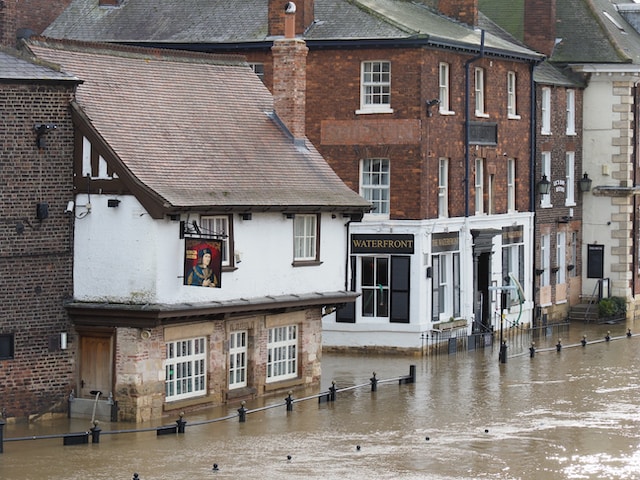Creating a disaster recovery plan can feel like an uphill battle.
The truth is, when it’s time to safeguard your business from potential disasters, the main concern often is…
Developing a comprehensive disaster recovery plan.
Many businesses lack knowledge on how to create a disaster recovery plan. But here’s the thing – having a solid disaster recovery plan in place separates a vulnerable business from one that’s resilient and prepared for any eventuality.
Making one of these plans isn’t easy, so we’ve built this guide to help you out!
Table of Contents:
- The Importance of a Disaster Recovery Plan
- Essential Elements of a Disaster Recovery Plan
- Types of Disasters Covered by a Recovery Plan
- Constructing Your Essential Disaster Recovery Plan: A Guide
- Benefits of Having a Disaster Recovery Plan
- Regular Testing & Updating Your Disaster Recovery Plan
- FAQs in Relation to Disaster Recovery Plan
- Conclusion
The Importance of a Disaster Recovery Plan

Whether you’re running a small start-up or heading up an established corporation, having a disaster recovery plan (DRP) is not just important – it’s essential. This well thought out strategy serves as your organisation’s roadmap to navigate through various disruptive events.
A comprehensive disaster recovery plan, however, goes beyond immediate response actions. It provides guidelines on what steps need to be taken in both short-term and long-term scenarios following any disruption.
Data Protection: A Cornerstone of Disaster Recovery Plans
In this digital age where data drives businesses forward, safeguarding these valuable assets becomes paramount during unforeseen disruptions. Data loss could mean losing years’ worth of invaluable information which might never be fully recoverable – impacting both day-to-day operations and strategic planning for future growth.
An effective disaster recovery plan incorporates robust backup procedures designed specifically for protecting your business-critical data from potential losses due to physical infrastructure damages caused by calamities. These measures ensure that even if onsite facilities are compromised, your vital records remain safe and accessible remotely – enabling you to continue functioning with minimal interruption.
Prioritising Financial Planning within Your DRP
Beyond securing physical resources and preserving digital assets, financial considerations also play an integral role in managing crisis situations effectively. Unplanned expenses associated with restoring normalcy post-disruption can quickly escalate if not properly managed via detailed financial strategies embedded within your overall DRP framework.
This includes earmarking emergency funds, exploring suitable insurance coverage options, estimating costs at different stages of restoration work, etc., all aimed towards mitigating potential monetary losses arising from sudden setbacks. Remember – being financially prepared often makes a difference between swift bounce-backs versus prolonged downtimes.
Essential Elements of a Disaster Recovery Plan
A disaster recovery plan is like your business’s safety net. It can save you from falling into the abyss when disaster strikes, be it fire, flood, or power outage.
Backup Procedures and Data Protection
The cornerstone of any solid disaster recovery plan is backup procedures. Regularly duplicating critical systems and storing them in secure off-site locations or cloud-based platforms could mean the difference between sinking and swimming during disruptive events.
Data protection measures are another key piece of this puzzle. Think encryption tools, uncrackable passwords, and two-factor authentication methods – all geared towards keeping sensitive information safe from theft or corruption.
Setting Recovery Objectives
Your next step should involve setting clear-cut recovery objectives – think RPOs (Recovery Point Objective) and RTOs (Recovery Time Objective). The former helps determine how much data loss your organization can withstand before things go south, while the latter outlines how long IT systems can stay down post-disruption without causing significant damage to operations. ISO 27031:2011 provides guidance for ICT readiness, which includes defining these crucial metrics within its scope. These concepts arm businesses with strategies that ensure they bounce back swiftly when faced with different types of disaster scenarios.
Types of Disasters Covered by a Recovery Plan

In the world of disaster recovery plans, it’s crucial to account for an array of physical disasters that could potentially halt your business operations. The typical threats to be accounted for are inundations, blazes, tempests and power cuts.
Floods are notorious for causing substantial damage to both buildings’ structures and their contents. They can also lead to extended downtime due to necessary drying-out periods and restoration work in affected areas. Having a well-thought-out flood response strategy embedded within your disaster recovery plan is key here.
Then we have fires – another serious threat with the potential for extensive property destruction as well as data loss if servers or other critical hardware fall victim. Hence why fire safety measures alongside robust response planning around fires play such pivotal roles in any solid disaster recovery procedures.
Tackling Storm Damage & Power Outages
Beyond these natural disasters lurk storms which can cause significant havoc on properties, leading to structural damages requiring considerable repair before normal operations resume again. Therefore, outlining steps needed after storm damage should be part and parcel of every comprehensive disaster recovery plan that defines instructions.
Apart from the direct harm caused by the aforementioned events, they often trigger power outages too – effectively disrupting all electronic systems until electricity supply returns. This may result in a communication breakdown or lack of access to important digital resources during this period. To counteract this risk factor, consider including strategies like backup generators at hand or using uninterruptible power supplies (UPS) systems to provide emergency power when main electrical sources fail, thus ensuring continuity amidst unexpected disruptions.
Your DRP needs flexibility to cover different types of disruptive events while being specific enough so that everyone knows what their role is when ‘disaster strikes’.
Constructing Your Essential Disaster Recovery Plan: A Guide

In the face of unexpected disruptions, having a disaster recovery plan is not just beneficial; it’s vital. This process involves various essential steps.
Potential Disasters: Identifying and Understanding Risks
The first port of call in crafting your disaster recovery plan? Recognising potential disasters that could put a spanner in the works for your operations. From natural disasters like floods or fires to man-made disruptions such as power outages and cybercrime, there is a wide range of potential threats that should be accounted for.
Beyond these obvious threats, consider scenarios that might fly under the radar but still pose significant risks – think data breaches or hardware failures. FEMA provides resources on identifying and understanding different types of hazards which can be useful during this stage.
Evaluating Critical Business Needs: Prioritise To Protect
Your next task is discerning what aspects are critical cogs in your business machine. Customer service functions, IT systems and financial processes often top this list among others.
To aid with this evaluation, you may want to carry out a Business Impact Analysis (BIA). A BIA helps pinpoint areas where disruption would cause severe financial loss thus guiding focus when planning for possible disasters.
Gathering Information & Creating Documentation: The Blueprint For Recovery
With likely threats identified and their impact evaluated against crucial parts of your business, now comes gathering information about how each area operates normally. This includes tasks performed within these areas along with any dependencies they have on other parts of the organisation.
This detailed info forms part of an extensive written document outlining responses during different disruptive events – essentially serving as a guidebook for restoring normalcy after disruption strikes.
Benefits of Having a Disaster Recovery Plan
Questioning why you should possess a disaster recovery plan? Well, let’s get into it.
The first benefit that springs to mind is the capacity to keep business ticking along, even when chaos reigns. That’s right – with a comprehensive disaster recovery plan at your fingertips, you can ensure minimal disruption for clients and uphold their trust in your brand during tumultuous times.
Mitigating Economic Losses
Beyond maintaining operations though, an effective DRP plays a crucial role in easing financial loss. Time truly is money here; any delay in restoring normalcy after disruptive events like natural disasters or power outages translates directly into lost revenue. Your DRP serves as your roadmap back to productivity by clearly outlining how swiftly critical systems should bounce back (the Recovery Time Objective), thus curbing potential losses.
A Proactive Approach: The Power of Preparedness
An underrated aspect of crafting such plans lies within its ability to foster forward-thinking about possible threats lurking around corners – this proactive approach has been shown time and again to significantly slash downtime during real-life crisis situations because employees know exactly what steps they must take next.
This preparedness not only minimises panic but also fosters efficient decision-making processes which are indispensable during high-stress scenarios brought on by unforeseen circumstances like power outages or fires.
Safeguarding Reputation & Customer Trust
Last up on our list but certainly no less important is the safeguarding of one’s company reputation – arguably one’s most valuable asset. Prolonged service disruptions or data breaches could seriously tarnish public perception towards brands. However, swift response times post-disruption have consistently demonstrated higher customer satisfaction levels so ensuring services are restored quickly via established procedures helps maintain consumer confidence through thick and thin.
Regular Testing & Updating Your Disaster Recovery Plan
The world of disaster recovery is ever-changing, with new threats emerging and the business environment constantly evolving. It’s vital to keep your DRP up-to-date so it can effectively combat these challenges.
Here are some key tips on conducting tests, reviewing results and making necessary updates for an effective disaster recovery plan.
1. Regularly Test Your DRP
To ensure effectiveness in a real-life disruptive event scenario, you need to put your disaster recovery procedures through their paces regularly. These tests will highlight any potential gaps or weaknesses that could impact its implementation when disaster strikes.
A variety of test types exist such as tabletop exercises, walk-throughs and full-scale simulations – choose one based upon what aspects of the plan you wish to evaluate . Remember – practice makes perfect.
2. Update As Needed
Your organisation isn’t static; neither should be your DRP. Any changes within organisational structure or systems upgrades must reflect in the plan promptly along with alterations related to risk factors like natural disasters patterns or cyber threat landscapes.
If discrepancies were discovered during testing or if there have been significant changes since creating it initially, prioritise addressing them swiftly through updates. This keeps plans created relevant enough against changing circumstances ensuring they restore operations quickly after disruption occurs.
3.Schedule Tests & Updates Consistently Over Time
Create a schedule for both testing and updating whether annually comprehensively reviewed, more frequent minor checks throughout year etc., keeping routine assessments help prevent data loss by maintaining critical system protection amidst varying conditions.
FAQs in Relation to Disaster Recovery Plan
What are the five phases of a disaster recovery plan?
The five phases include: Prevention, Mitigation, Preparedness, Response, and Recovery. Each phase plays a crucial role in managing disasters effectively.
What are the four phases of a disaster recovery plan?
The four stages consist of: Mitigation, Preparedness, Response, and Recovery. These stages ensure businesses can handle disruptions and restore operations swiftly.
What are the three types of disaster recovery plans?
The three types encompass Data Centre Disaster Recovery Plan, Cloud-Based Disaster Recovery Plan, and Virtualized Disaster Recovery Plan. Each type caters to different business needs.
What is the difference between BCP and DRP?
A Business Continuity Plan (BCP) focuses on maintaining business functions during a crisis, while a Disaster Recovery Plan (DRP) prioritises restoring IT infrastructure post-disruption.
Conclusion
Understanding the significance of a disaster recovery plan is step one.
You’ve now delved into its essential elements, including backup procedures and setting recovery objectives.
The various types of disasters that such plans cover have been explored, from fires to power outages.
We’ve walked you through creating your own disaster recovery plan, highlighting critical steps like identifying potential disasters and evaluating business needs.
The role IT systems play in these plans has been discussed along with the numerous benefits having a robust strategy can bring to your business.
With real-life case studies under our belt, we understand how effective planning minimises damage and restores operations quickly during crises. Regular testing and updating are vital for an evolving business environment against emerging threats.
We hope when it comes time to developer your Disaster Recovery Plan, that we become you trusted service providers for restoration services if the worst comes to pass! If you have any questions, then feel free to get in touch with us, or you can also take a look through our testimonials page! Happy planning!




